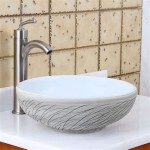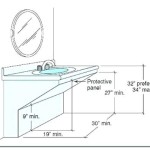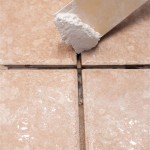Replace Stand Alone Bathroom Sink: A Comprehensive Guide
Replacing a stand-alone bathroom sink may seem like a daunting task, but with the right tools, materials, and a step-by-step guide, you can easily tackle this DIY project. Whether you're refreshing your bathroom's decor or upgrading to a more functional sink, follow these comprehensive instructions for a successful replacement.
1. Gather Necessary Tools and Materials
Before starting the replacement process, ensure you have all the necessary tools and materials at hand. This includes:
- Adjustable wrench
- Pliers
- Screwdriver
- Putty knife
- Bucket
- Sponge
- New sink
- Faucet
- Drain assembly
- Sink strainer
- Plumber's putty
- Teflon tape
2. Prepare the Bathroom Sink Area
Begin by clearing the area around the sink. Remove any items from the sink, such as toiletries, soap dispensers, or toothbrush holders. Spread a drop cloth or old towels around the sink to protect the floor from water and debris.
3. Turn Off Water Supply
Locate the water supply valves under the sink. These are typically two separate valves, one for hot water and one for cold water. Turn the valves clockwise until they are fully closed to stop the water flow to the sink.
4. Disconnect the Drain Assembly
Place the bucket underneath the sink to catch any water or debris that may fall during the removal process. Using the adjustable wrench, loosen the slip nuts that connect the drain assembly to the sink. Once loosened, carefully detach the drain assembly from the sink.
5. Remove the Old Sink
If your sink is secured with mounting brackets, use the screwdriver to remove the screws that hold the brackets in place. Gently lift the sink off the countertop and place it in the bucket or on the drop cloth. Be careful not to drop or damage the sink during removal.
6. Clean the Countertop
Use the putty knife to scrape off any old sealant or residue from the countertop surface where the sink was installed. Wipe the area clean with a damp sponge to remove any remaining debris.
7. Install the New Sink
Apply a bead of plumber's putty around the drain hole in the countertop. Press the new sink firmly into place, ensuring that the drain hole aligns with the putty. Use the adjustable wrench to tighten the slip nuts that secure the drain assembly to the sink.
8. Connect the Faucet
Wrap the threads of the faucet with Teflon tape. Screw the faucet into the appropriate holes in the sink, hand-tightening until snug. Use the adjustable wrench to tighten the faucet securely, being careful not to overtighten and damage the faucet.
9. Reconnect the Drain Assembly
Reinstall the drain assembly by sliding it into the drain hole from underneath the sink. Hand-tighten the slip nuts until snug, then use the adjustable wrench to tighten them securely. Ensure that the drain assembly is properly aligned and there are no leaks.
10. Turn On the Water Supply
Slowly open the water supply valves under the sink, one at a time. Check for any leaks around the sink, faucet, and drain assembly. If you notice any leaks, tighten the connections until the leak stops.
11. Install the Sink Strainer
Place the sink strainer in the drain hole to prevent debris from entering the drain. Secure the strainer by tightening the screws or clips that hold it in place.
Congratulations! You have successfully replaced your stand-alone bathroom sink. Enjoy your new and refreshed bathroom space.

How To Install A Pedestal Sink Elevate Your Bathroom

How To Remove And Replace A Bathroom Sink Diy

How To Install A Pedestal Sink Elevate Your Bathroom

4 Ways To Replace A Bathroom Sink Wikihow

Here S How Install A Bathroom Pedestal Sink

Diy Guide Find Out How To Replace A Bathroom Sink Ron Hazelton

How To Replace And Install A Bathroom Sink

How To Install A Freestanding Bathroom Vanity Cherished Bliss

How To Install A Bathroom Vanity

4 Ways To Replace A Bathroom Sink Wikihow







